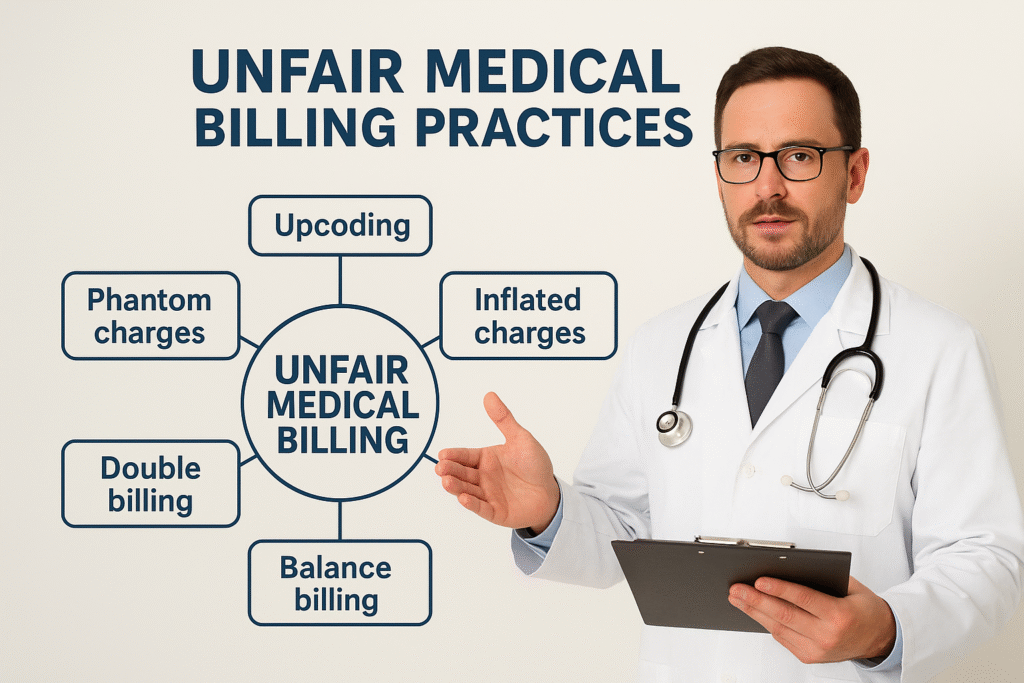Introduction
Ambulance medical billing (AMB) is a highly specialized process that focuses on reimbursement for emergency and non-emergency medical transportation services. Unlike standard medical billing, ambulance billing involves unique rules related to medical necessity, transport type, and mileage. Without careful handling, patients may encounter unfair medical billing practices, which can cause confusion, financial strain, and mistrust between providers and patients.
For ambulance providers, accurate billing ensures timely reimbursement, compliance with regulations, and financial stability. For patients, it guarantees transparency and fairness in healthcare charges. This makes ambulance billing a critical component of the broader healthcare revenue cycle.
How Is Ambulance Billing Different From Traditional Medical Billing?
Traditional medical billing usually covers services like hospital stays, physician visits, and outpatient care. Ambulance billing, however, presents its own challenges. Payments are not solely based on procedures performed but also on transport details, including the distance traveled and the urgency of the situation.
Unlike routine medical claims, ambulance billing requires thorough documentation of why a patient needed ambulance transport, including medical necessity and the patient’s condition at the time. This makes ambulance billing more complex, leaving more room for errors that can easily lead to unfair medical billing practices if not managed properly.
Ambulance Billing & Coding Services
Ambulance billing services extend beyond simple claim submission. These specialized services include patient eligibility verification, proper coding of services, and handling denials. Many ambulance providers outsource these functions to experienced billing companies because the rules governing transportation reimbursements can be complicated.
A strong billing and coding service helps:
- Ensure accurate CPT and HCPCS coding
- Minimize claim denials by adhering to payer rules
- Track accounts receivable effectively
- Support compliance with state and federal regulations
Looking to improve your practice’s billing efficiency? Understanding key billing principles
Ambulance Billing and Collections
Collections are an important step in ambulance billing. This stage involves securing payment either from insurers or from patients when balances remain after insurance.
Providers must maintain transparency throughout the process by explaining charges clearly, documenting why ambulance transport was necessary, and following up on unpaid balances. Collections also involve negotiation with payers to resolve disputes quickly. Without effective collections management, ambulance providers may experience revenue delays and strained patient relationships.
AMB CPT Codes
CPT and HCPCS Level II codes form the backbone of ambulance billing. Each code reflects the type of service provided, whether it is basic life support, advanced life support, or air transport. These codes ensure standardized reporting and fair reimbursement. Incorrect or incomplete coding can result in claim rejections, delayed payments, or compliance issues.
Ambulance Coding Guidelines
Ambulance billing must follow strict coding guidelines set by CMS and private payers. These guidelines require accurate documentation, which includes the patient’s condition, the origin and destination of transport, and the level of service provided. Mileage must also be recorded precisely.
Failure to comply with these rules not only leads to denied claims but also exposes providers to audits and penalties. That’s why coding guidelines form the foundation of reliable and compliant ambulance billing.

Ambulance Billing Codes
Ambulance services use a specific range of billing codes under HCPCS. These codes allow providers to indicate the exact level of service:
- A0425: Ground mileage
- A0426: Advanced life support, non-emergency
- A0427: Advanced life support, emergency
- A0433: ALS Level 2 transport
- A0434: Specialty care transport
Correct application of these codes is essential to ensure proper payment and avoid disputes.
Ambulance Billing Modifiers
Modifiers add critical details to ambulance claims by showing where the transport began and ended. Each two-letter modifier corresponds to an origin and destination. For instance:
- RH: Residence to hospital
- SH: Scene to hospital
- NH: Nursing home to hospital
- DH: Diagnostic facility to hospital
Without modifiers, claims lack important context and are likely to be denied. Proper use of modifiers ensures compliance and more accurate payments.
Ambulance CPT Codes List
A complete list of ambulance CPT codes helps billing professionals stay consistent. Some of the most commonly used codes include:
- A0428: Basic life support, non-emergency
- A0429: Basic life support, emergency
- A0430: Fixed wing air transport
- A0431: Rotary wing air transport
- A0435: Advanced life support mileage
- A0436: Specialty care mileage
Having a reference list ensures coders can quickly identify the correct code for each scenario.
Discover how technology is transforming medical billing processes and improving efficiency.
Compliance in Ambulance Medical Billing
Compliance is one of the most critical elements in ambulance billing. Providers must follow Medicare, Medicaid, and private payer guidelines while maintaining accurate patient documentation. Non-compliance exposes organizations to revenue loss and regulatory penalties.
Essential compliance practices include:
- Verification of medical necessity
- Accurate use of CPT and HCPCS codes
- Proper application of modifiers
- Detailed trip reports with patient condition and transport details
Technology in Ambulance Billing
Technology has transformed ambulance billing by reducing human error and improving claim accuracy. Advanced billing platforms and EHR systems help automate coding suggestions, streamline claims submissions, and track revenue cycles in real time. Analytics tools also provide insights into trends such as frequent denials, making it easier for providers to address recurring problems.

Patient Transparency in Ambulance Billing
One of the leading causes of disputes in ambulance billing is a lack of transparency. Patients are often shocked by unexpected bills, especially when out-of-network transport services are used. To avoid this, providers should offer:
- Clear and easy-to-understand billing statements
- Upfront communication about coverage and costs
- Flexible payment plans for patients
Improving transparency not only builds trust but also prevents complaints about unfair medical billing practices.
Table: Key Elements of Ambulance Medical Billing
| Element | Description |
|---|---|
| Transport Type | Emergency / Non-Emergency |
| Mileage | Distance traveled |
| Medical Necessity | Proof of patient condition |
| Modifiers | Origin and destination codes |
| CPT/HCPCS Codes | Service-level identifiers |
| Compliance | Payer and federal requirements |
Challenges in Ambulance Billing
Ambulance billing providers face several ongoing challenges. The most significant issues include frequent payer denials, strict documentation requirements, and constantly changing insurance rules. In addition, disputes with patients over high ambulance costs remain common.
These challenges make it critical for ambulance providers to invest in staff training, billing software, and compliance audits.
The Future of Ambulance Billing
The future of ambulance billing is expected to emphasize patient-centered practices, advanced technology, and stronger regulations. Artificial intelligence and automation will reduce claim errors, while new laws will work to protect patients from unfair medical billing practices. Transparency, compliance, and efficiency will remain the core pillars of the ambulance billing industry moving forward.
Conclusion
Ambulance medical billing is more than just coding and claims it is a system that ensures providers are reimbursed fairly while protecting patients from unnecessary financial burdens. With proper coding, compliance, and transparent communication, the industry can overcome its challenges and move toward a more accurate and patient-friendly approach.
FAQs
What are ambulance billing modifiers?
Ambulance billing modifiers are two-letter codes that indicate the origin and destination of transport. Examples include RH (Residence to Hospital) and SH (Scene to Hospital). These modifiers are essential for accurate claim submission.
How can patients avoid unfair medical billing practices in ambulance services?
Patients can reduce the risk of unfair medical billing practices by reviewing insurance coverage in advance, requesting itemized bills, asking providers about in-network status, and clarifying transport necessity whenever possible.
What role does compliance play in ambulance billing?
Compliance ensures billing accuracy and adherence to payer, state, and federal guidelines. It helps prevent denials, audits, and financial penalties while ensuring ethical billing practices.
Why are ambulance bills often higher than expected?
Ambulance bills may be higher due to out-of-network services, mileage charges, or advanced life support requirements. Lack of billing transparency also contributes to patient surprise bills.

